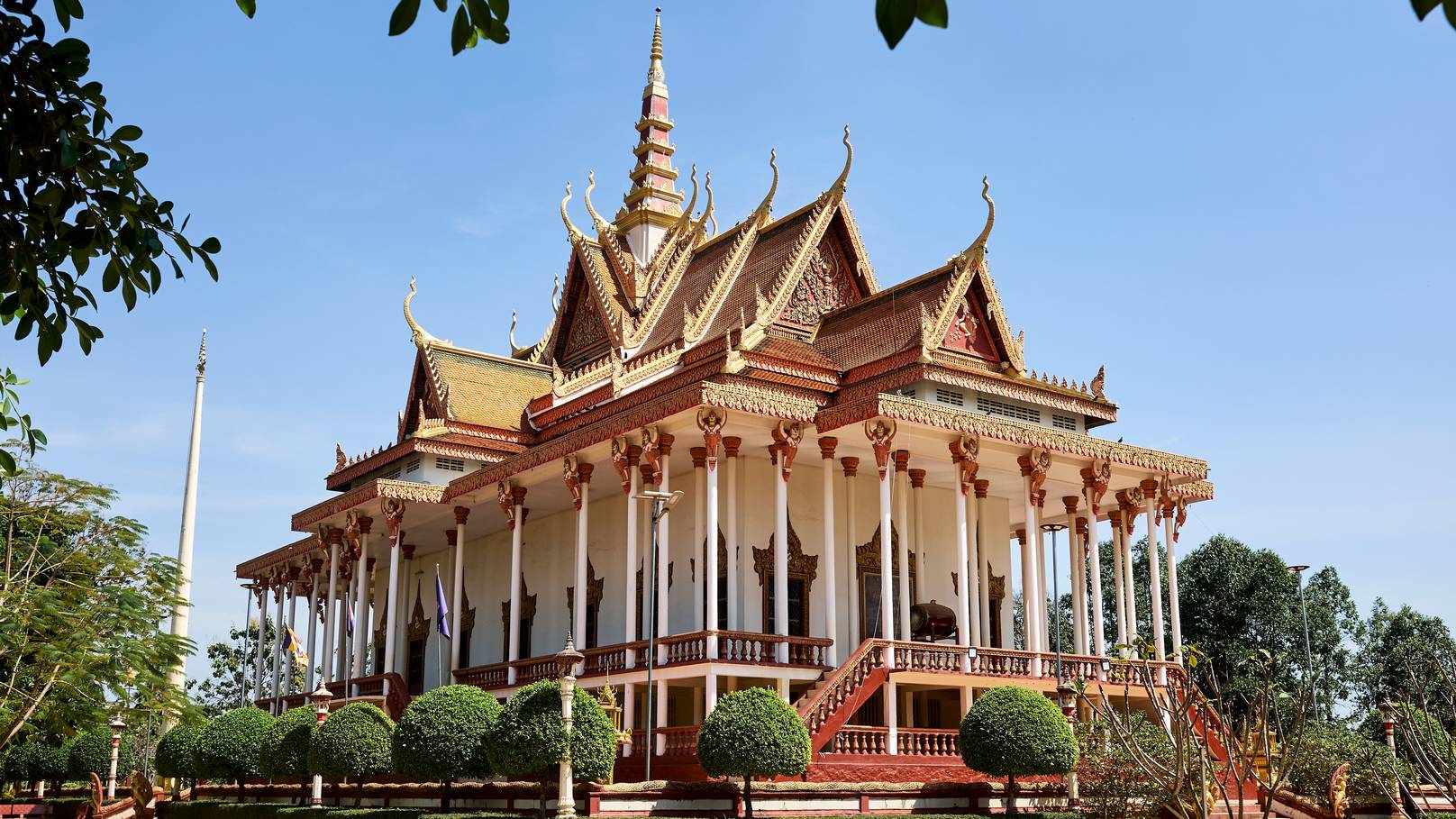🛕 Welcome to WatGuide – Buddhist temple meaning
Unlock the meaning behind the temples.
Are you planning a trip to Asia and want to visit Buddhist temples?
Or have you already wandered through temple grounds, fascinated by the statues, murals and rituals – but left with more questions than answers?
You’re not alone.
Temples across Asia are places of deep Buddhist temple meaning, ancient tradition and silent beauty.
But unless you know what to look for, much of it remains invisible.
WatGuide helps you see more.
We explain the gestures, the symbols, the architecture – and the stories behind them.
So your next temple visit will be not just beautiful, but meaningful.
„Because: You only see what you know.“
🧘 Learn what the images mean, how to behave respectfully – and what you can discover if you look closely.
🛕 What You Might See in a Buddhist Monastery
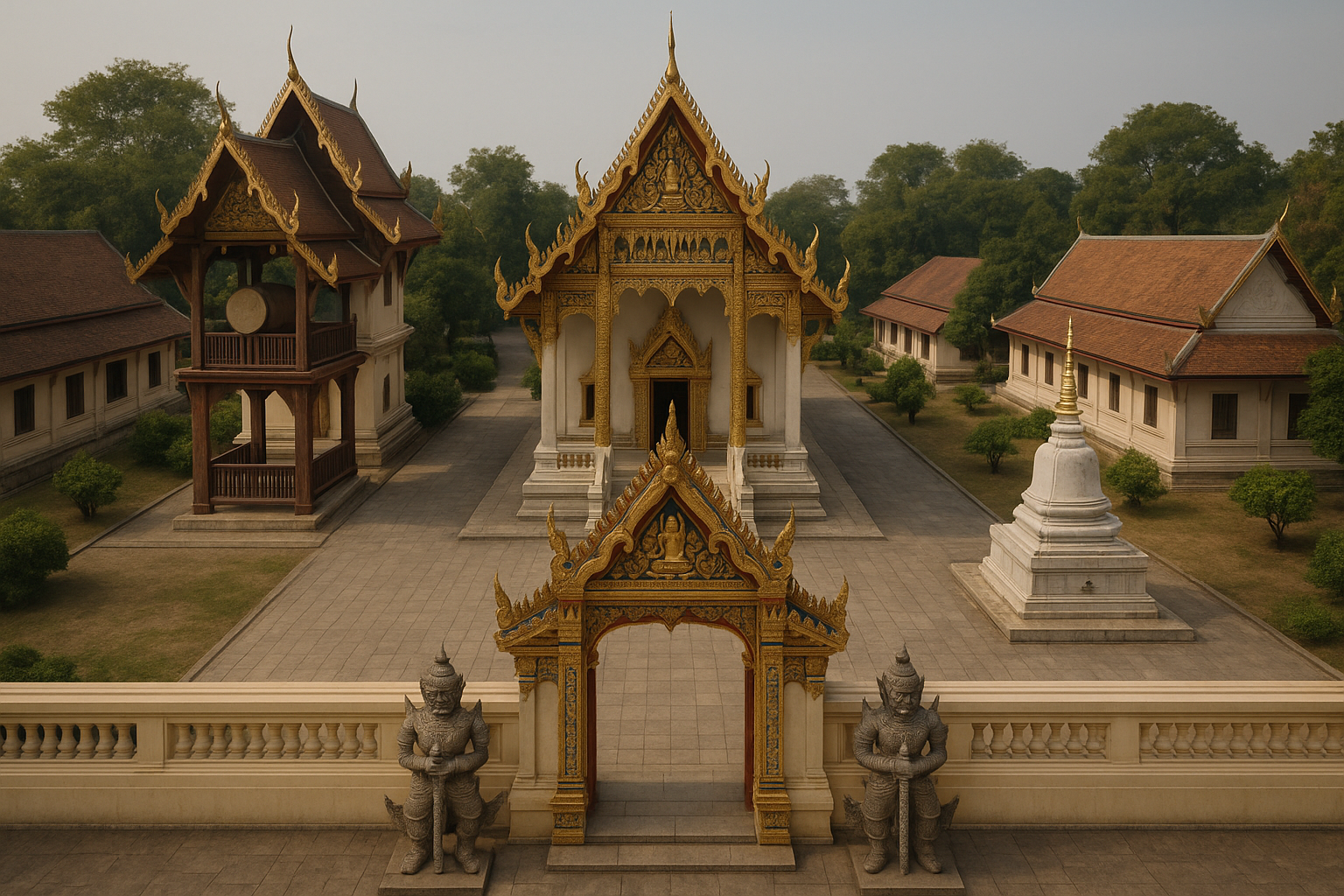
An overview of typical temple buildings – and what they mean. Buddhist temple grounds (especially in Southeast Asia) are often part of a larger monastery complex. You don’t just see one temple – you enter a world with many sacred spaces, each with its own function and symbolism. Here’s a quick guide to the main structures you might encounter:
📍 Gate Guardians & Courtyards Before you enter, you may meet mythic creatures: lions, demons, dragons – protectors of the Dharma. The courtyards are often lined with murals from Buddha’s life.👉 Learn more—
📍 Main Temple Hall (Ubosot / Vihāra / Bot) The spiritual heart of the monastery . Large Buddha statues, wall paintings, and chanting ceremonies take place here. 👉 Learn more—
📍 Stupa or Pagoda (Chedi / Thāt / Chörten) A tower-shaped structure often holding sacred relics. Symbol of enlightenment and cosmic harmony. 👉Learn more—
📍 Drum Tower A small open tower with a large wooden drum.Used to signal rituals, prayer times, or community gatherings.👉 Learn more—
📍 Bell Tower Often opposite the Drum Tower. The bell marks time, opens ceremonies or honors the dead. 👉 Learn more—
📍 Monks’ Quarters (Kutis) Simple wooden huts or small houses where monks live and meditate. Usually in quieter areas of the grounds. 👉 Learn more—
📍 Dharma Hall / Library A place for teaching, script recitation or storing sacred texts. Often decorated with reliefs or statues of important teachers. 👉 Learn more—
🧭 Tip for Visitors:> When you enter a temple ground, take a moment to pause.Look around slowly – what can you recognize?
„The more you understand, the more you’ll see.“
🚪 Gate, Guardian Figures & Courtyard
Crossing into sacred space
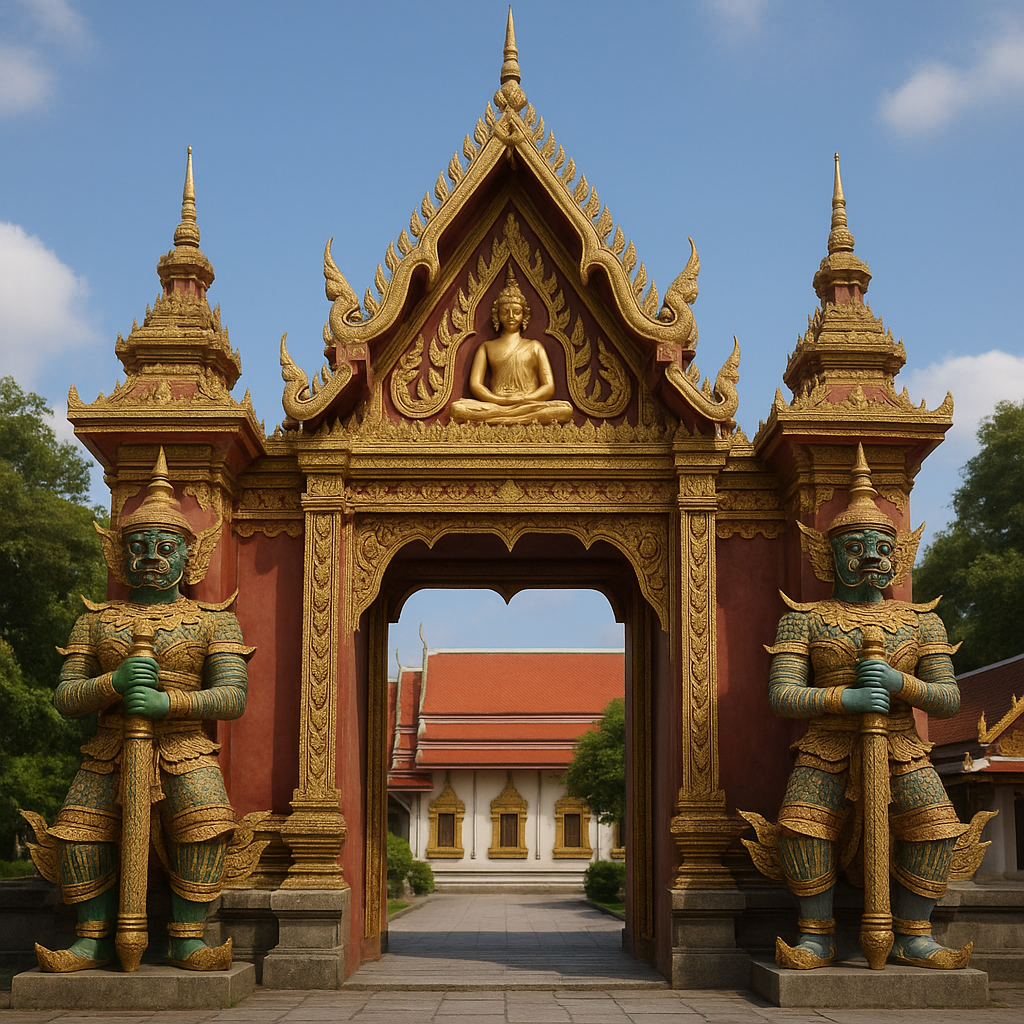
When entering a Buddhist temple or monastery, you don’t simply walk through a gate – you cross a threshold. What lies beyond is a space set apart from everyday life. The entrance, guardian statues, and the first open courtyard form the transitional zone between the ordinary and the sacred.
🚪 The Gate – more than an entrance
In many traditions, the gate is symbolic: you leave behind distractions, desires, and worldly thoughts.
- In Thailand, it may resemble a pointed arch, often adorned with nagas (serpent spirits)
- In Japan, the red torii marks the entrance to a sacred Shinto or Buddhist site
- In Tibet, gates are often richly painted with protective symbols like the eight auspicious signs
„Walking through the gate is an act of intention – a moment of inner pause.“
🛡️ Guardian Figures – protectors of the Dharma
On either side of the entrance, you’ll often see statues of fierce deities, mythical beasts, or ancient warriors. Their role is to ward off evil and remind visitors to purify their minds before entering.
Common examples include:
- Yakshas or Dvarapalas (India/Thailand): muscular guardian spirits
- Niō (Japan): wrathful gate deities, one with mouth open (birth), one closed (death)
- Lions or dragons (China/Vietnam): protectors and symbols of vigilance
These figures are not meant to scare – they are there to protect the sacred space and your inner journey.
⛩️ The Courtyard – a space to breathe
Immediately after passing the gate, you often enter a spacious open courtyard – the heart of the temple grounds.
- It serves as a gathering space for ceremonies and festivals
- It provides perspective and stillness before approaching the main temple
- Often, you’ll find a stupa, flagpoles, or incense stands here
„The courtyard is where body and breath adjust to the sacred.
Let yourself slow down – look, smell, listen.“
👀 What to observe:
- What symbols are carved into the gate or painted on the columns?
- What animals or figures guard the entrance – and why those?
- Do you feel a change in atmosphere between outside and inside?
„Before you see the Buddha, you pass the guardians.
Before you pray, you must pause.“
🛕 Main Temple Hall (Ubosot / Vihāra / Bot) Buddhist temple meaning
The spiritual heart of the monastery
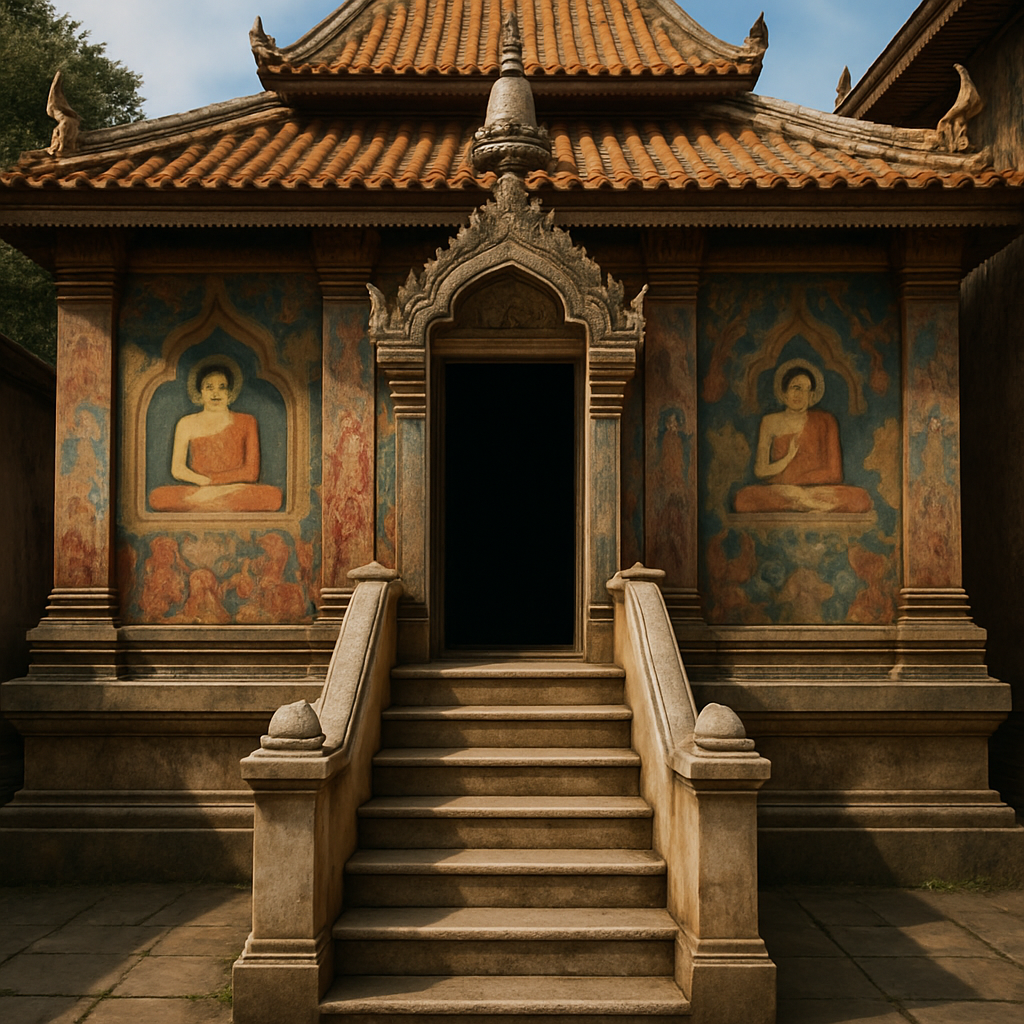
The main temple hall is usually the most sacred and architecturally impressive building within a Buddhist monastery. Depending on the region and tradition, it may be called:
- Ubosot (Thailand – most formal ordination hall)
- Vihāra (Sri Lanka, India – often a general temple hall)
- Bot (alternative Thai term for the ordination hall)
- Main Hall / Daeungjeon (Korea), Hondō (Japan)
🔍 What happens here?
The main temple hall is where the most important rituals take place. This is where monks gather to chant sutras, perform ceremonies, and receive ordination. Visitors often come here to pray, make offerings, or simply sit in silence. Buddhist temple meaning.
You’ll usually find:
- A large Buddha statue, often seated in meditation or touching the earth (Bhūmisparśa mudrā)
- Murals or reliefs showing scenes from the Buddha’s life (especially birth, awakening, first sermon, death)
- Altars with candles, flowers, and incense
- A central axis aligned with the entrance – symbolizing the path to enlightenment
👣 How to behave inside:
- Remove your shoes before entering
- Dress respectfully (covered shoulders and knees)
- Avoid pointing your feet at the altar
- Keep your head lower than that of a monk or Buddha statue
- Remain silent or speak softly
- Bowing is a sign of respect, not submission – feel free to join in quietly
🧘 Symbolism & Design
The temple hall often represents the Buddha’s presence in the world.
Its elevated platform, roof tiers, and guardian figures reflect the idea of ascending from ordinary life to spiritual insight.
Some halls are surrounded by boundary stones (sema stones in Thailand) – marking the sacred ground where only monks may perform certain rituals like ordination.
🧭 Look closer:
- Can you identify the Buddha’s hand gesture (mudrā)?
- Are the paintings showing a journey – perhaps the Buddha’s life story? Understanding the key moments in the Buddha’s life helps you recognize the stories told through temple murals — and gives deeper meaning to what you’re seeing.
- Is the roof decorated with Nāgas (serpents), Garudas, or lotus motifs?
„The more you know, the more you see.
This is the place where silence speaks loudest.“
🌀 Stupa / Pagoda
A cosmic monument to the Buddha’s presence
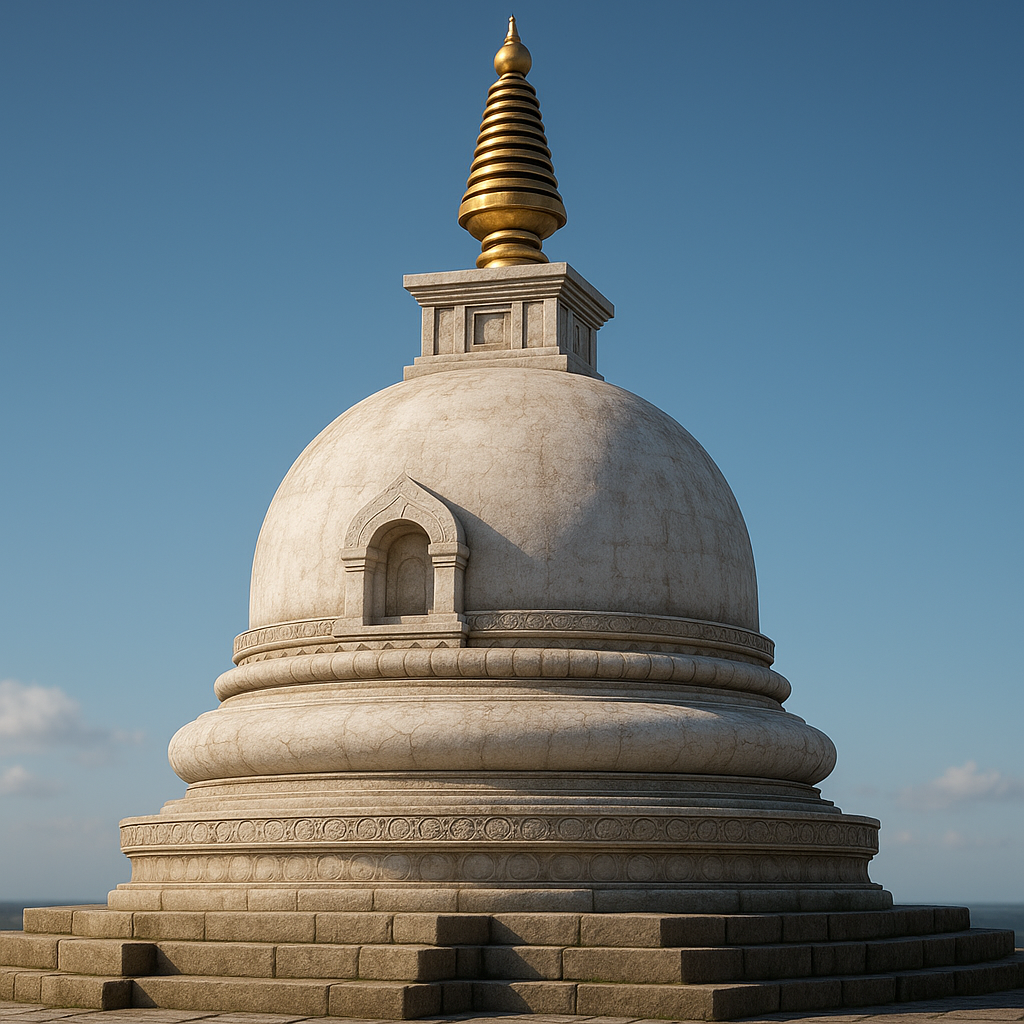
The stupa (or pagoda in East Asia) is one of the oldest and most symbolic structures in Buddhist architecture. More than just a striking tower or dome, it serves as a spiritual compass, a relic shrine, and a representation of enlightenment itself.
Wherever you find one – in the jungle of Laos, on a Tibetan plateau, or beside a modern Thai temple – the stupa connects the visible with the invisible.
🪷 What is a stupa?
Originally, a stupa was a burial mound holding relics of the Buddha or enlightened monks. Over time, it evolved into a sacred architectural form, often closed to visitors but deeply revered.
In Southeast Asia (Thailand, Myanmar, Laos), it is called chedi or that.
In East Asia (China, Japan, Korea), the stupa was transformed into a pagoda, often with multiple tiers.
🔍 What does it symbolize?
The structure is a three-dimensional mandala – a cosmic diagram.
Its key elements mirror the path to enlightenment:
- Base: Earth – stability, moral discipline
- Dome / body: Water – meditative absorption
- Spire: Fire – wisdom
- Lotus parasols: Air – spiritual progress
- Tip: Space – awakening
Some stupas contain sacred relics (hair, ash, robes), others house texts or symbolic offerings.
„Even if you don’t believe in relics, standing before a stupa can stir awe.
It is meant to elevate thought, slow time, and center the mind.“
🧘 How to approach a stupa:
- Walk clockwise (circumambulate) in silence or meditation
- Don’t touch or climb the structure – it is sacred
- Offer incense or flowers at the base, not on the stupa itself
- Bow or place your palms together before you leave
🏯 Pagoda vs. Stupa:
- Pagodas are often multi-tiered towers – visual reinterpretations of the stupa in China, Korea, and Japan
- Unlike stupas, some pagodas can be entered or climbed
- Despite the form, the spiritual intent remains the same: veneration and connection
👀 What to look for:
- Does the stupa contain gold leaf, gems, or mirrors?
- Are there small niches with Buddha statues?
- Do people walk around it, kneel, or light incense nearby?
- Buddhist temple meaning
“You don’t go inside a stupa.
The stupa is already inside you – it reflects your mind at peace.”
🥁 Drum Tower
Sound that awakens
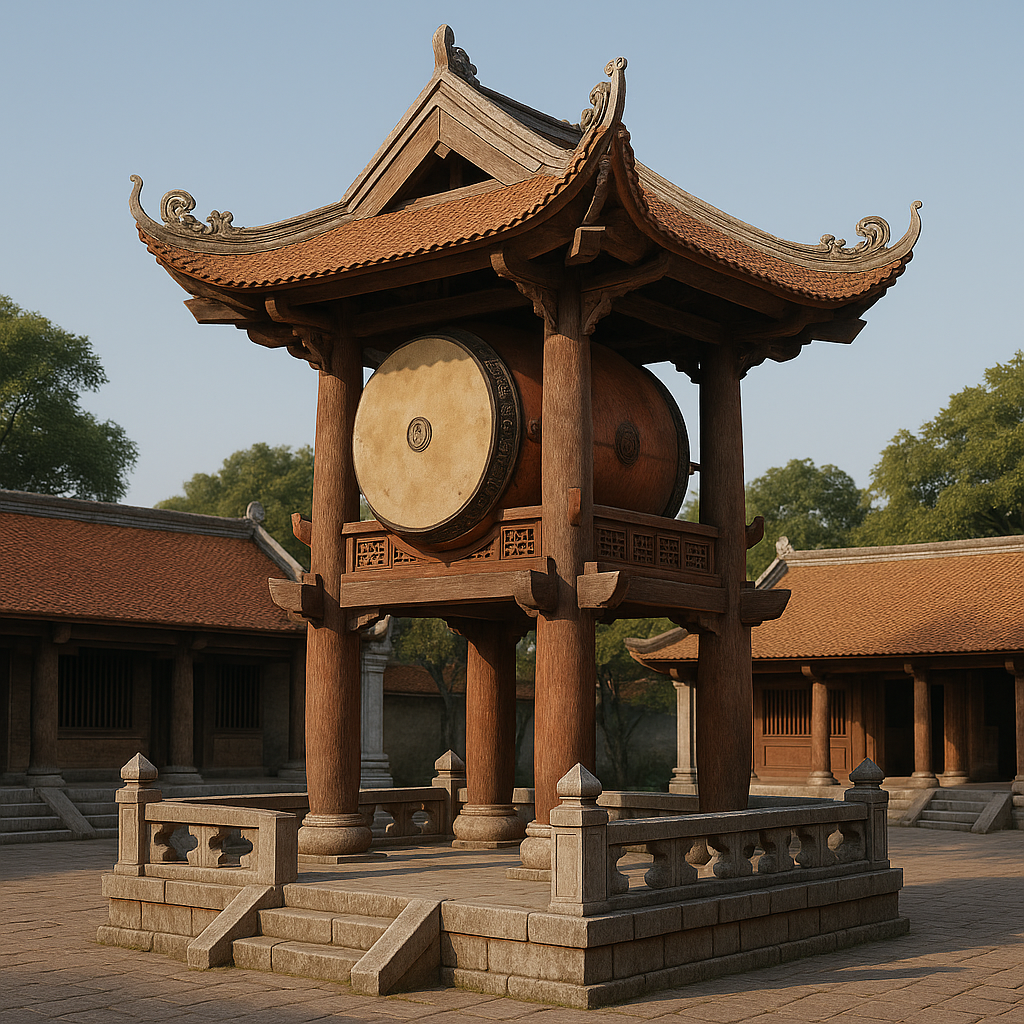
The drum tower is a small, often elevated structure found in many Buddhist temple complexes. Modest in size, but rich in meaning, it houses a large drum whose deep, resonant sound marks the rhythm of monastic life.
Together with the bell tower, it forms a sacred pair: sound and silence, call and presence.
🔍 What is it used for?
The drum isn’t just a time signal – it is a sonic ritual. It resonates through the temple grounds and into the minds of all who hear it.
It is traditionally used to:
- Announce the beginning of dawn or dusk
- Mark ceremonial times or meditation sessions
- Call monks and laypeople to the main hall
- Celebrate special occasions or festivals
„The first drumbeat at dawn is called the drum of awakening – not just from sleep, but from ignorance.“
🧘 Symbolism of the drum
The drum is said to disperse negative energies and awaken wisdom. Its low, earthy tone represents the grounding force of mindfulness.
- The beating of the drum is like the heartbeat of the Dharma
- In some traditions, it also symbolizes the Buddha’s voice, spreading across space
- The vibration is meant to resonate in both the body and mind of the listener
🏯 Architecture & Placement
- Often placed opposite the bell tower for balance
- Housed in an open-sided pavilion or small tower
- The drum itself may be painted, engraved, or wrapped in sacred cloth
- In larger temples, novices may be trained to drum in ceremonial patterns
👀 What to look for:
- Is the tower square or round? How is the drum suspended?
- Are there symbols or inscriptions on the drum surface?
- Are people gathering or pausing when it is struck?
🙏 How to behave:
- Do not strike the drum yourself unless invited – it is part of ritual order
- When the drum sounds, pause. Many locals will instinctively bow or reflect
- If you’re nearby, close your eyes and listen fully
“The drum does not teach with words – it teaches with vibration.
Let it echo in you.”
🔔 Bell Tower
Echoes of impermanence
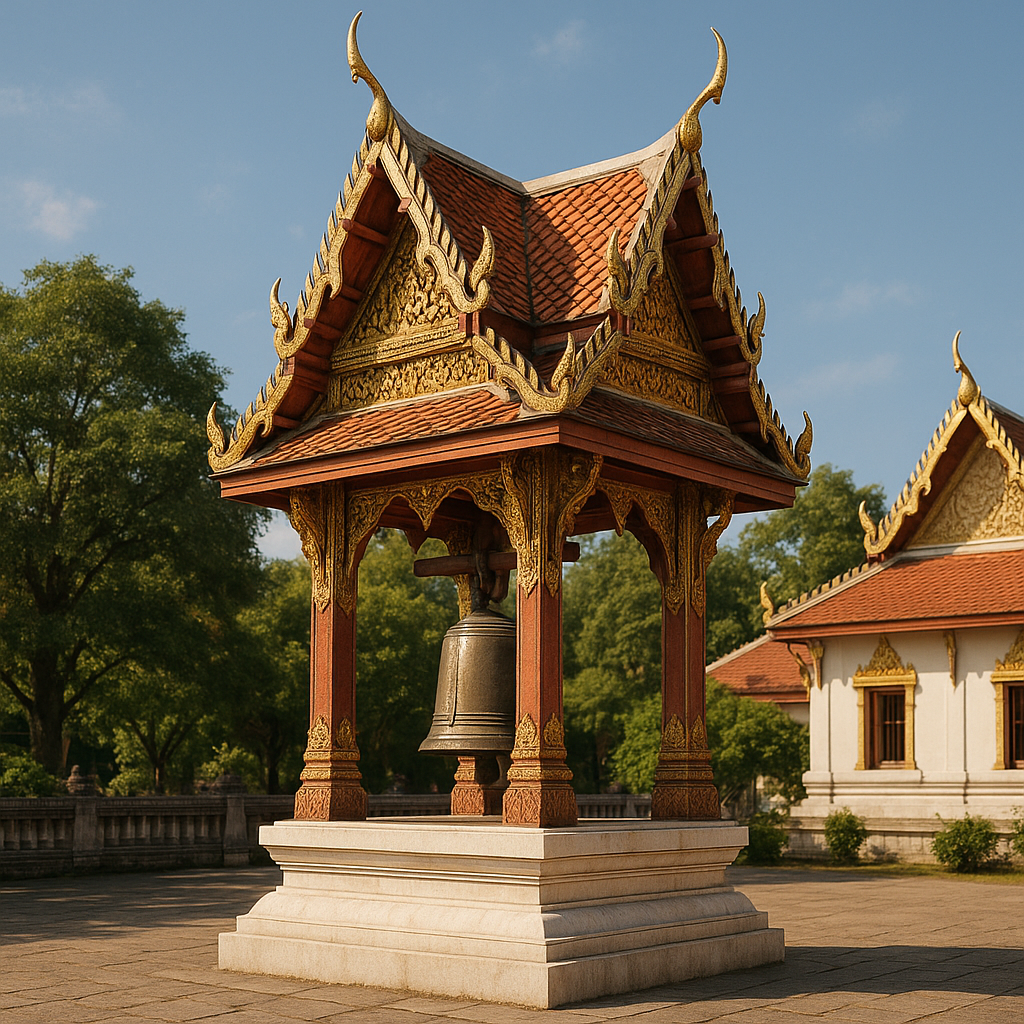
The bell tower is a central feature of many Buddhist temple complexes. Often standing across from the drum tower, it houses a large ceremonial bell – sometimes taller than a person – whose deep tone carries across the temple grounds and beyond.
In Buddhist thought, the bell is more than a musical instrument: it is a reminder of transience, a call to mindfulness, and a symbol of awakened awareness.
🔍 What is it used for?
The bell is struck at key moments in the daily temple rhythm:
- At dawn: to greet the new day with awareness
- Before rituals and chanting sessions
- To mark moments of transition – beginnings and endings
- On special days, such as Vesakh or full moons
In Japan and Korea, temple bells (bonshō / beomjong) are often rung 108 times on New Year’s Eve, symbolizing the purification of the 108 earthly desires.
The sound is not just heard – it’s felt. In the chest. In the breath. In the moment.
🧘 Symbolism of the bell
The bell is the voice of the Dharma – calm, clear, penetrating.
- Its sound symbolizes emptiness and clarity
- The echo fades slowly, teaching the listener about impermanence
- Striking the bell is an act of invitation, not noise
The striker (usually a suspended wooden beam) is often gently swung, not aggressively hit – the act itself is mindful.
🏯 Design & Placement
- The bell tower is usually an open pavilion with pillars, often ornately carved
- The bell may bear inscriptions, mantras, or images of Buddhas and bodhisattvas
- In Tibetan temples, smaller handbells (ghanta) are used in tantric rituals
- Some temple bells are hundreds of years old and revered as sacred artifacts
👀 What to look for:
- Is the bell decorated with sacred symbols or text?
- Is the striker suspended horizontally or on a frame?
- Does the bell tower mirror the position of the drum tower?
🙏 How to behave:
- Do not ring the bell unless invited or guided to do so
- If you witness the bell being rung: pause, listen, breathe
- Some visitors place their hands in prayer or bow during the ringing – follow respectfully
“The bell is a teacher that never speaks.
Yet its message is always clear:
Pause. Be still. You are here.”
🛏️ Monks’ Quarters (Kutis)
Where simplicity meets sacred life
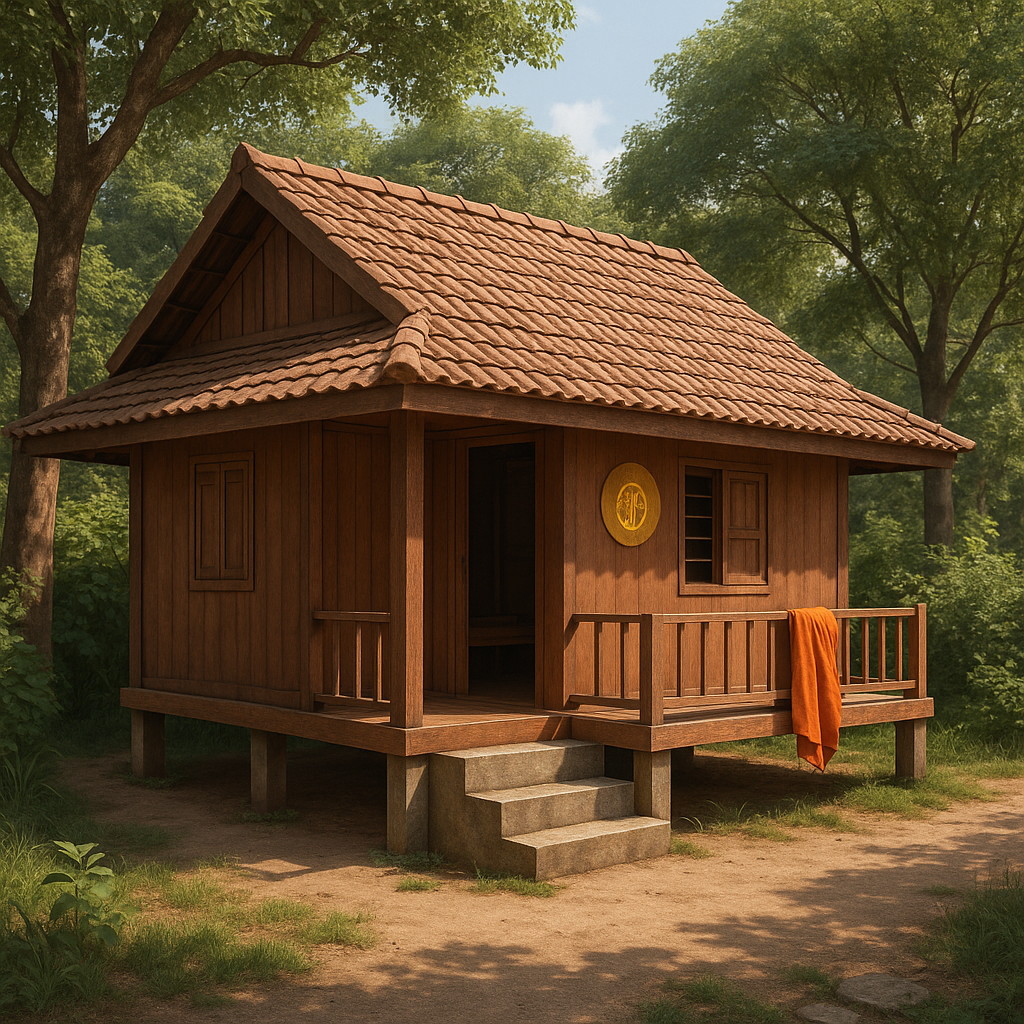
Behind the majestic temples and symbolic structures of a Buddhist monastery lies a quieter, humbler zone: the monks’ living quarters. Known in many Theravāda traditions as kutis, these dwellings are where monks rest, study, meditate, and live out the teachings they uphold.
They may seem unremarkable at first glance – but they are at the heart of monastic life.
🏠 What are kutis?
A kuti (from Pali/Sanskrit, meaning “hut” or “small room”) is a basic, often single-person dwelling.
- Built for simplicity and solitude
- Found scattered throughout the monastery, often in quieter or shaded areas
- Can be simple wooden huts, concrete cells, or rooms in a shared dormitory
In forest monasteries, kutis may be far apart and surrounded by nature. In city temples, they may form compact rows or be part of a larger residence building.
„Each kuti is a space for practice, not comfort.“
👨🦲 Who lives here?
- Fully ordained monks (bhikkhus)
- Novices (sāmaṇeras)
- Occasionally: lay renunciants or long-term retreatants (with permission)
This is where monks:
- Wake before dawn
- Meditate, read, or chant between communal duties
- Observe the Vinaya (monastic code), which includes rules about food, posture, silence, and clothing
🧘 Symbolism & Function
Monks’ quarters embody the Buddhist ideals of:
- Simplicity (only essential belongings allowed)
- Renunciation (freedom from material attachment)
- Discipline (structured routine, ethical living)
Often, the kuti is a metaphor for the mind: when kept clean, quiet, and uncluttered, insight can arise.
👀 What to observe (from a respectful distance):
- Are the kutis grouped or separate?
- Are there robes drying outside? Meditation cushions on a porch?
- Do you see a small altar or incense stand near the doorway?
- Often, a kuti will have shoes placed neatly outside – a sign of presence
🙏 How to behave:
- Do not enter the monastic living areas unless invited
- Walk quietly if near this zone
- Avoid taking photos unless you have permission
- If you see a monk outside his kuti, a respectful nod or prayer gesture (anjali) is appreciated
This is not a tourist zone – it’s a living practice space.
Your awareness here shows your respect.
“The kuti is a cell of freedom.
Within its silence, monks meet the truth.”
📖 Dharma Hall (Dhamma Hall / Teaching Hall)
Where the teachings come to life
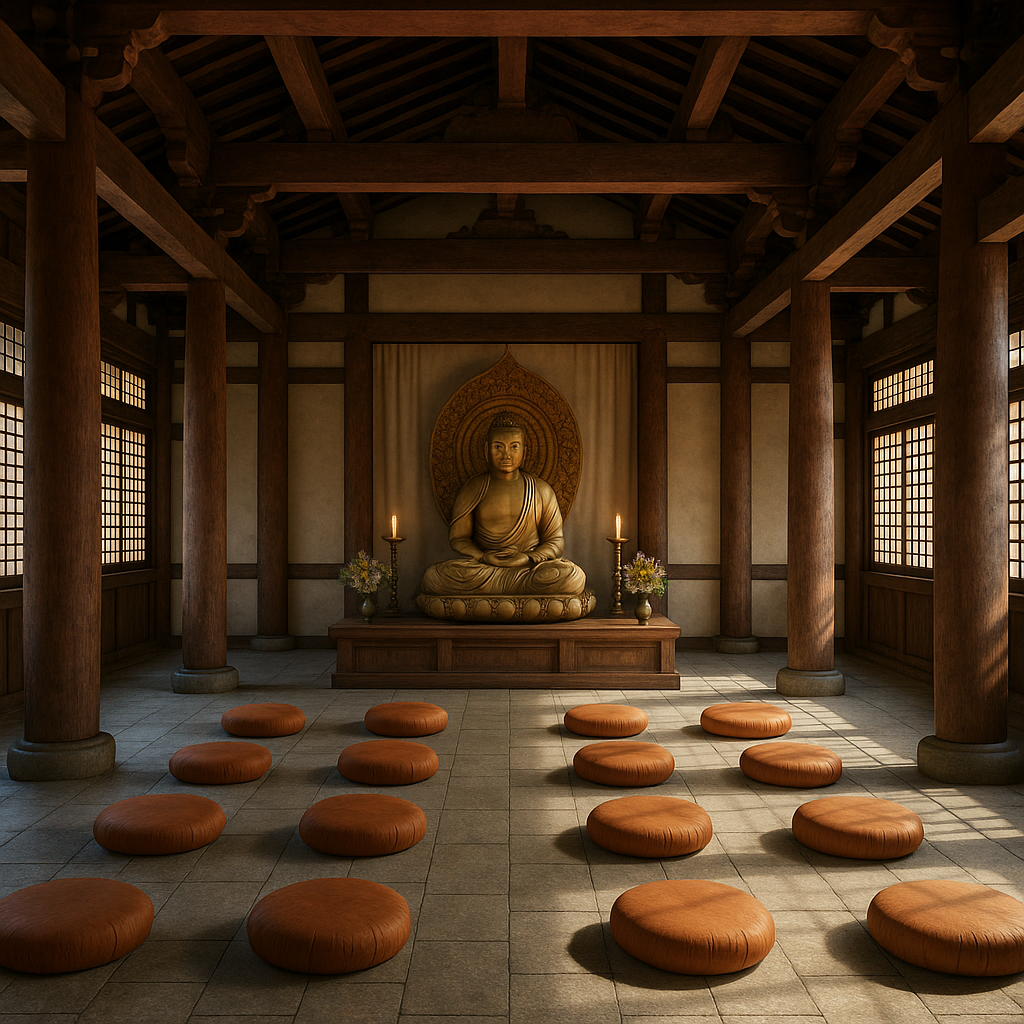
While the Main Temple Hall is a space for ritual and veneration, the Dharma Hall is the classroom of enlightenment. This is where monks teach, discuss, and chant the Buddha’s teachings (Dharma or Dhamma) – not just as theory, but as living wisdom.
It is a place of shared learning, reflection, and verbal transmission – echoing the Buddha’s own gatherings under the Bodhi tree.
📚 What happens in the Dharma Hall?
Depending on tradition and monastery size, the Dharma Hall may be used for:
- Formal Dharma talks (desanas) by senior monks or abbots
- Scripture study, chanting practice, or memorization
- Meditation instructions for lay visitors or retreat groups
- Q&A sessions between monastics and the public
- Puja recitations or ceremonies during festivals
In many Theravāda monasteries, the Dhamma Hall is open to all – monks, novices, and laypeople alike.
It is a place where the Buddha’s words meet your questions.
🏯 Layout & Architecture
- Often a spacious, open-air pavilion or large hall with minimal decoration
- May contain a simple Buddha image and seating cushions
- In larger temples, equipped with microphones, fans, and script shelves
- Shoes are always removed, and respectful silence is kept
Some Dharma Halls double as meditation halls, while others are reserved strictly for teaching.
🧘 Symbolism
- The Dharma Hall represents the voice of the Buddha still echoing in the world
- It is a space of transmission – not visual awe, but verbal clarity
- Sitting here reminds the listener: wisdom is a shared journey
In Zen monasteries, a similar function is held by the Hōjō or lecture hall. In Vajrayāna settings, this may be called the Gompa or Teaching Temple.
👀 What to observe:
- Is there a central teaching seat or throne for the abbot?
- Are texts like the Pali Canon or sutra scrolls present?
- Are laypeople seated apart from monks – or mixed together?
Often, you’ll hear chanting in Pali, Sanskrit, Tibetan, or local languages – rhythmic, melodic, and calming.
🙏 How to behave:
- Sit respectfully (cross-legged or kneeling) – never point feet at the teacher
- Avoid whispering or leaving during a talk
- Bow slightly before and after entering
- If you don’t understand the language – just listen with presence
Wisdom doesn’t require translation – it begins with attention.
“The temple shows the Buddha.
The Dharma Hall helps you hear him.”
